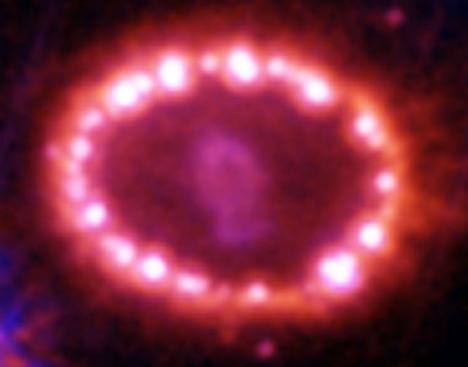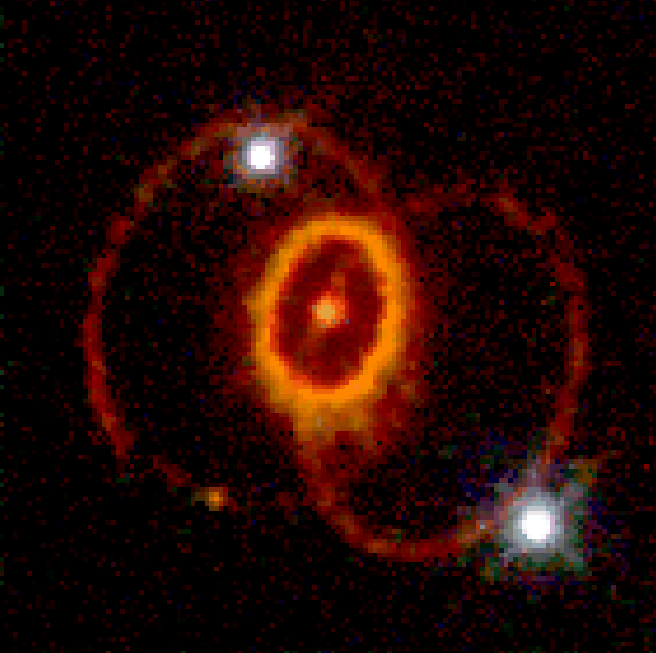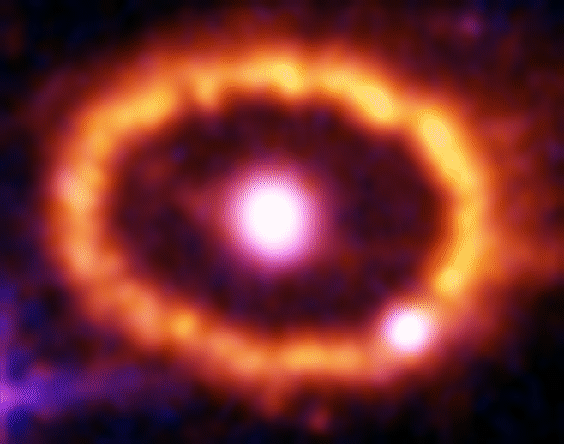Observing the NASA photograph of sn1987a and the particle energized radiation pearls are a real mind bender and quite perplexing. Joe tries to fit together a couple of scenarios for the unusual current visual display of sn1987a visible from the Hubble telescope.
 First off, any 'Supernova may not be a Supernova but just a
plain type I nova.
How so?
When two black holes come together they do so under extreme
accelerating velocity as they both have a spacetime dimple
os deep that it stops time. So it amounts to a freefall
into utterly immense gravity. (which scientists call warped
spacetime)
Further:
(Note: Remember this is all Joseph_Sixpack intuition stuff
again and NOT science)
As they converge to merge in their binary orbit to either a
stable binary orbit or a total merger, depending upon unique
dynamic factors, a zero gravity port is formed, and
depending upon the orbit speed and the centifugal dynamics
involved, a huge amount of radiation finds its way out the
zero gravity port and onto various paths, one of which was
directed toward our solar system and reached us here in
early 1987.
This focused and directed radiation from sn1987a, if assumed
to be ejected in a spherical fashion would lead to erroneous
assumptions of a much higher solar mass event, than in fact,
actually happened.
The obvious intuitive assumption here by Joseph_Sixpack is
that sn1987a was not a spherical eruption but a zero gravity
port event.
The focused and directed radiation coming out or off a zero
gravity port leads to an assumption of a MUCH smaller albeit
concentrated radiation event.
Examining the 'innards' of sn1987a pearl structure, which is
dimensionally about a light year across, you can see why the
'pearls are 'lighting up' the core now has developed another
zero gravity port or ports and the escaping radiation or
plasma from them are interacting with the surrounding
particle 'pearls'.
Two questions arise:
Question 1: Are the generating elements within the
remainder of sn1987a core elements 'evaporating' to beneath
the ability of them to warp spacetime to effect a escape
velocity of c? That is, will Escv be less than
the velocity of c?
If so, when will the escape velocity drop to beneath c and
allow a second or third massive total radiation escape er...
'nova' to occur? (probably in the nature of a type I
scenario) since Escv is at the baseline of
'blackholeness', anything less will not contain radiation
and ultraheated plasma.
Of course, the implication from my view is that NO mini
black holes can exist beneath the mass necessary to create
an escape velocity in excess or equal to c, which linearly
is about 500 solar masses, plus or minus a couple. Mass
needs ultra compression to generate ultra gravity, or more
properly, ultra spacetime warpage, otherwise just champaign
bubbles exist with insufficient mass. No mass, no black
hole.
The mass required, in fact, be a lot less than that, oh...
say... as a blind guess around 274 solar masses maybe.
Acceleration of the escape velocity parameter may not be
linear. Or it may be. Guesswork in this area is best left
to the computer heads.
To stop time, you need a LOT of mass.
no mass - no black hole.
mini's don't exist. period.
warping spacetime isn't a job for lightweights.
onto:
Question 2: Will the internal orbiting factions within
sn1987a configure themselves and act to form a wok shaped
zero gravity port and thereby close off all escaping plasma
and radiation and in so doing, turn off the plasma and
radiation hitting the 'dust' making up the 'pearls' circling
the binary or higher orbiting systems at the core, which are
causing the illumination and the brightness of the 'pearls
necklace'?
Again, if the second happening occurs then we can expect the
lighted 'pearls' to turn off as the escaping elements from
the core of sn1987a will be interdicted by the closure of
the zero gravity port or ports.
Now... how long is all this going to take? for the processes
to occur causing either another standard type I nova or a
complete cessation of the pearl necklace.
i haven't the faintest. Maybe a year... maybe shorter...
maybe 50 years... maybe longer... So don't hold your
breath. The cosmos isn't on our observing schedules.
First off, any 'Supernova may not be a Supernova but just a
plain type I nova.
How so?
When two black holes come together they do so under extreme
accelerating velocity as they both have a spacetime dimple
os deep that it stops time. So it amounts to a freefall
into utterly immense gravity. (which scientists call warped
spacetime)
Further:
(Note: Remember this is all Joseph_Sixpack intuition stuff
again and NOT science)
As they converge to merge in their binary orbit to either a
stable binary orbit or a total merger, depending upon unique
dynamic factors, a zero gravity port is formed, and
depending upon the orbit speed and the centifugal dynamics
involved, a huge amount of radiation finds its way out the
zero gravity port and onto various paths, one of which was
directed toward our solar system and reached us here in
early 1987.
This focused and directed radiation from sn1987a, if assumed
to be ejected in a spherical fashion would lead to erroneous
assumptions of a much higher solar mass event, than in fact,
actually happened.
The obvious intuitive assumption here by Joseph_Sixpack is
that sn1987a was not a spherical eruption but a zero gravity
port event.
The focused and directed radiation coming out or off a zero
gravity port leads to an assumption of a MUCH smaller albeit
concentrated radiation event.
Examining the 'innards' of sn1987a pearl structure, which is
dimensionally about a light year across, you can see why the
'pearls are 'lighting up' the core now has developed another
zero gravity port or ports and the escaping radiation or
plasma from them are interacting with the surrounding
particle 'pearls'.
Two questions arise:
Question 1: Are the generating elements within the
remainder of sn1987a core elements 'evaporating' to beneath
the ability of them to warp spacetime to effect a escape
velocity of c? That is, will Escv be less than
the velocity of c?
If so, when will the escape velocity drop to beneath c and
allow a second or third massive total radiation escape er...
'nova' to occur? (probably in the nature of a type I
scenario) since Escv is at the baseline of
'blackholeness', anything less will not contain radiation
and ultraheated plasma.
Of course, the implication from my view is that NO mini
black holes can exist beneath the mass necessary to create
an escape velocity in excess or equal to c, which linearly
is about 500 solar masses, plus or minus a couple. Mass
needs ultra compression to generate ultra gravity, or more
properly, ultra spacetime warpage, otherwise just champaign
bubbles exist with insufficient mass. No mass, no black
hole.
The mass required, in fact, be a lot less than that, oh...
say... as a blind guess around 274 solar masses maybe.
Acceleration of the escape velocity parameter may not be
linear. Or it may be. Guesswork in this area is best left
to the computer heads.
To stop time, you need a LOT of mass.
no mass - no black hole.
mini's don't exist. period.
warping spacetime isn't a job for lightweights.
onto:
Question 2: Will the internal orbiting factions within
sn1987a configure themselves and act to form a wok shaped
zero gravity port and thereby close off all escaping plasma
and radiation and in so doing, turn off the plasma and
radiation hitting the 'dust' making up the 'pearls' circling
the binary or higher orbiting systems at the core, which are
causing the illumination and the brightness of the 'pearls
necklace'?
Again, if the second happening occurs then we can expect the
lighted 'pearls' to turn off as the escaping elements from
the core of sn1987a will be interdicted by the closure of
the zero gravity port or ports.
Now... how long is all this going to take? for the processes
to occur causing either another standard type I nova or a
complete cessation of the pearl necklace.
i haven't the faintest. Maybe a year... maybe shorter...
maybe 50 years... maybe longer... So don't hold your
breath. The cosmos isn't on our observing schedules.
The Parallel Barrel Staves
 Okay... Now imagine a straight line through space.
At some point on the line, select a single point, P.
At that point place two closing and accelerating black hole
objects in perpendicular orbit around that point P on the
line.
Or, if you think appropriate, place two binary black hole
orbiting systems in perpendicual orbit at that point P to
create a double binary closing and accelerating black hole
orbits, for a total population of four closing black holes
total at the point on the line.
Now at that point again, place about roughly a 90 degree
cone point along parallel on the line facing one way and
then place another cone of the same description facing the
other way on the line. So now you have two cones, point to
point, on the line.
Now imagine the whole thing, black holes and the two cones
pointing in the opposite directions surrounded by a two
light year diameter 'dust' sphere which has had all the
'dust' within, already mostly accreted into the orbiting
black holes, leaving skin band of dust of unknown thickness
at the two light year diameter point or at a one year radius
point.
Now as the plasma and radiation escapes out the zero gravity
port, the first thing it hits is the outer 'dust covering'
surrounding the closing binary systems.
As the relatively thin escaping radiation walls of the cone
hit the 'dust covering' surrounding sn1987a, the irradiated
dust lights up and creates the appearance of two parallel
barrel staves around sn1987a, with one 'barrel stave' for
each of the two cones which are really made up of radiation
and plasma being ejected out the zero gravity port from each
end of the cones.
Now the two eruptions of 1987a were a half year apart
according to the position of the staves and the pearls.
The pearls are one half light year in radius and the staves
are looking like a light year in radius or close to it.
With the pearls lighting up again it looks light there might
be another closing blast from the binaries within sn1987a
coming down the pike, the lightup is caused by escaping
radiation and plasma from the zero gravity port, or ports,
of the masses involved.
look closely at the following animation. You can see the
center losing mass rapidly. expect another minor nova as the
escape velocity of the central binary objects drops below
the velocity of light, c.
Okay... Now imagine a straight line through space.
At some point on the line, select a single point, P.
At that point place two closing and accelerating black hole
objects in perpendicular orbit around that point P on the
line.
Or, if you think appropriate, place two binary black hole
orbiting systems in perpendicual orbit at that point P to
create a double binary closing and accelerating black hole
orbits, for a total population of four closing black holes
total at the point on the line.
Now at that point again, place about roughly a 90 degree
cone point along parallel on the line facing one way and
then place another cone of the same description facing the
other way on the line. So now you have two cones, point to
point, on the line.
Now imagine the whole thing, black holes and the two cones
pointing in the opposite directions surrounded by a two
light year diameter 'dust' sphere which has had all the
'dust' within, already mostly accreted into the orbiting
black holes, leaving skin band of dust of unknown thickness
at the two light year diameter point or at a one year radius
point.
Now as the plasma and radiation escapes out the zero gravity
port, the first thing it hits is the outer 'dust covering'
surrounding the closing binary systems.
As the relatively thin escaping radiation walls of the cone
hit the 'dust covering' surrounding sn1987a, the irradiated
dust lights up and creates the appearance of two parallel
barrel staves around sn1987a, with one 'barrel stave' for
each of the two cones which are really made up of radiation
and plasma being ejected out the zero gravity port from each
end of the cones.
Now the two eruptions of 1987a were a half year apart
according to the position of the staves and the pearls.
The pearls are one half light year in radius and the staves
are looking like a light year in radius or close to it.
With the pearls lighting up again it looks light there might
be another closing blast from the binaries within sn1987a
coming down the pike, the lightup is caused by escaping
radiation and plasma from the zero gravity port, or ports,
of the masses involved.
look closely at the following animation. You can see the
center losing mass rapidly. expect another minor nova as the
escape velocity of the central binary objects drops below
the velocity of light, c.

Getting back to the barrel staves One issue of the intuitive interpretation is: Why are the walls of the generating cones of radiation so thin as to create 'barrel staves' instead of a solid cone of radiation reaction from the generating sources? One explanation my be that the zero gravity port may be so large that other central escaping radiation might be gravitationally bent over, if the system is made up of four orbiting masses instead of the usual two. There could even be three sets of binaries involved. But now the geometry gets complicated, fast. A supporting or dismissing look around, might reveal other 'barrel stave' phenomena in the cosmos that resemble the cosmic 'butterflies' generated by zero gravity port emissions and an impending cosmotic event or a complete shutoff by the spinning wok configuration of the unequal in mass, binary black holes. But remember, this is just an intuitive construction. The reality may be quite different. I'll leave it to the students and scientists to science it out and outguess me. Oops! almost forgot. The illuminated gas/particle sphere may not be a two lightyear spherical drawdown of mass into the black hole system we call sn1987a. The barrel stave illumination may be from tubular 'tunnels' within the cosmos as highly gravitational objects zoom around accreting mass, everincreasing the spacetime warpage as the putt-putt through the cosmos, creating temporary tubes of non-stuff. Well, the tube idea may explain one barrel stave but not the other one. The spherical scenario may be the more likely one. We can assume that if the sn1987a system was putt-putting along at some velocity over time, that it would leave a tubular somewhat 'empty' volume behind it as a result of its travels. Anyhow, that is the best a Joe can do for now with the information at hand. Again, check out all the sciencing info on google and google scholar and wikipedia. Oh... one more thing... don't go there.
more notes size distance barrel staves maybe more barrel staves maybe after 2nd or 3rd blast nature of present internal orbits number of orbiting objects binary, trinary, quatary... string of pearls visible in a spherical manner? yes? then... no? then... possible closing binaries with the zero gravity port pointed directly at us. Why pearls after 20 years? less energy from ejecta forthcoming turn off completely as radiation from zero gravity port causes emissions to become ineffective... not 100,000,000 solar masses at all, just appears that way due to zero gravity port emissions... what is inside the pearls? effect of wok shaped emission port over time s.